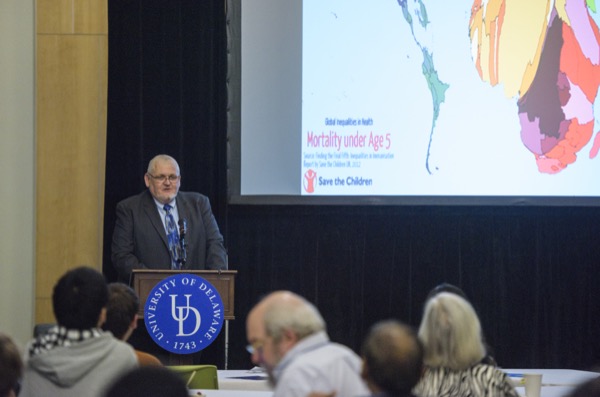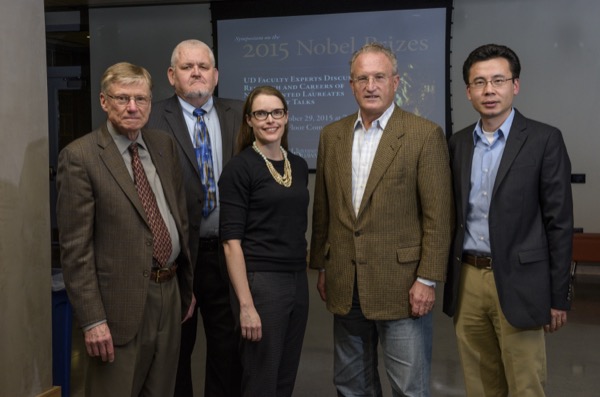


Nobels explained
UD faculty experts discuss 2015 laureates' prize-winning work
9:59 a.m., Nov. 3, 2015--Six University of Delaware faculty members with expertise in the areas of study that won this year’s Nobel Prizes discussed the significance of the laureates’ work at an Oct. 29 public event on campus.
Sponsored by the College of Arts and Sciences, the annual Nobel Symposium consists of six short talks and an opportunity for the audience to ask questions.
Campus Stories
From graduates, faculty
Doctoral hooding
The event is held each year as a way to give interested members of the UD community and the public more in-depth information about the laureates’ work than is typically found in general news stories about the prizes.
The speakers are faculty members who conduct research and scholarship in areas closely connected to the prize-winning work.
Following are the 2015 prizes highlighted at the symposium.
Medicine
John Jungck, professor of biological sciences and mathematical sciences, spoke about the Nobel Prize in Physiology or Medicine, which was given to William C. Campbell and Satoshi Omura for their discovery of a new drug to treat diseases caused by roundworm parasites and to Youyou Tu for her discovery of a new drug to treat malaria.
“This work had tremendous impact,” Jungck said, citing statistics on the high rates of debilitating illness and death from diseases caused by parasites, including mosquito-borne malaria. Such diseases particularly afflict the world’s poorest people and can be especially deadly to children.
“Most of our [U.S.] health budget gets spent on diseases of old white men” such as heart disease, Jungck said, but the global threat to human health is much greater from diseases such as malaria, river blindness and lymphatic filariasis, commonly known as elephantiasis — the diseases that the Nobel winners targeted.
Parasitic diseases are difficult to treat without harming the patient, and drugs that work for a time often lose their effectiveness, so the development of new therapies is crucial, Jungck said.
He also noted that Tu’s work is remarkable because she conducted her research at the Academy of Traditional Chinese Medicine in Beijing, rather than at a top-tier academic research facility, and because she is the first Chinese researcher working in China to win a Nobel Prize in the sciences. Although some observers have called her Nobel a victory for traditional medicine, Jungck said that Tu was inspired by that tradition but that she developed the new drug through rigorous scientific work.
Literature
Mark Bowden, instructor in English and Distinguished Writer in Residence, discussed Belarusian writer Svetlana Alexievich, who won the literature prize for what the Nobel Committee called “her polyphonic writings, a monument to suffering and courage in our time.”
A working journalist during the Soviet era, Alexievich “is easily the most self-effacing writer to ever have received the Nobel Prize for Literature,” Bowden said. He praised her method of telling stories directly through the words of those who experienced particular, often traumatic, events and not by creating her own narrative from those experiences.
“What she does is collect voices,” Bowden said, although she “filters them through her own sensibilities” and so may alter the words she quotes rather than strictly following traditional journalistic practices.
Her books, only two of them translated into English, deal with such subjects as the consequences of the 1986 nuclear disaster in Chernobyl, the experiences of soldiers during the Soviet Union’s war in Afghanistan from 1979-89 and everyday life for individuals under Soviet rule.
The “genius” of Alexievich’s approach, Bowden said, is that by telling her stories through the words of many different people, she “creates a chorus … a testimony of many, many witnesses” whose accounts often contradict the authoritarian messages of the state.
This 2015 prize marks the first time the Nobel in literature has been awarded to a journalist and the first time it’s gone to a nonfiction writer since Winston Churchill received it in 1953, Bowden said.
Economics
Adrienne Lucas, associate professor of economics, described the work done by Angus Deaton, awarded this year’s Sveriges Riksbank Prize in Economic Sciences in Memory of Alfred Nobel for his analysis of consumption, poverty and welfare.
She began her talk by showing examples of two unnamed countries and a few economic statistics for each. One had a somewhat higher average annual income, leading to an assumption that its residents were better off. But a look at other measures found that those residents also had much higher rates of poverty and child mortality, as well as a much lower life expectancy; the higher average income had been created by a windfall of oil revenue that enriched only a handful of citizens.
Lucas said Deaton posed the question: “Where is well-being higher?” and, as in the example, recognized the need to look beyond broad statistical averages and instead to “examine much more closely the individual life experiences of people.”
Much of his work focused on individual consumption patterns as a way to understand how consumers distribute their spending, how much of society’s income is spent or saved, and how to best measure and analyze wealth and poverty.
Deaton sought to understand those patterns in order to develop economic policies that will promote welfare and reduce poverty. To that end, he developed a Household Survey to measure wealth and poverty in a new way.
“This transformed the field of development economics from a purely theoretical approach to one that uses testable, empirical data,” Lucas said.
Physics
Thomas Gaisser, Martin A. Pomerantz Chair of Physics and Astronomy, spoke about the Nobel Prize in Physics, given to Takaaki Kajita and Arthur B. McDonald for the discovery of neutrino oscillations, which showed that neutrinos have mass.
Gaisser told the audience that there are three different types, known as “flavors,” of neutrinos — subatomic particles that have no charge and rarely interact with other particles. Electron neutrinos, one of those flavors, are produced in the sun through nuclear fusion.
Over years of measuring electron neutrinos in the atmosphere, Gaisser said, physicists were finding less than half the number they expected. Solving the puzzle of what happened to those missing neutrinos is what led to this year’s Nobel Prize selection.
Around the year 2000, Kajita discovered that neutrinos he was measuring at the Super-Kamiokande detector in Japan were changing their identities while in the atmosphere. Around the same time, McDonald, working at Canada’s Sudbury Neutrino Observatory, showed that neutrinos were not disappearing after leaving the sun but, instead, were arriving at the observatory with different identities.
Because these scientists’ experiments demonstrated neutron oscillation — the transformation from one flavor into another — they also showed that neutrons have a tiny amount of mass. Previously, neutrinos were considered to have no mass.
“For particle physics, this was a historic discovery,” the Nobel Prize organization said in a news releasing announcing the award. “The discovery has changed our understanding of the innermost workings of matter and can prove crucial to our view of the universe.”
Peace
Muqtedar Khan, associate professor of political science and international relations, discussed the Nobel Peace Prize, awarded this year to the Tunisian National Dialogue Quartet.
The quartet — made up of leaders of trade union, business, lawyer and human rights organizations — received the prize for what the Nobel Committee called its “decisive contribution to the building of a pluralistic democracy in Tunisia in the wake of the Jasmine Revolution” that launched the region’s Arab Spring uprisings in 2011. While many nations that were part of the Arab Spring have had setbacks including collapsed states and a return to military rule, Tunisia has been praised for its relatively peaceful transition to democracy and stability.
But, Khan noted in his talk, much of the commentary about the 2015 Peace Prize has been critical as well, pointing to the current Tunisian government’s questionable record on individual freedom and economic progress.
“The [Nobel Peace Prize] Committee sometimes gives the prize more for the promise than for what is delivered,” Khan said.
The quartet’s most powerful member was the labor union faction, he said, which brought its experience and success at negotiating to the process of establishing a constitution and peaceful democratic development after Tunisia’s previous authoritarian government was overthrown. The biggest accomplishment of the group was its ability to bring about compromise from different parts of society, a rarity in the Middle East, Khan said.
Although Tunisia has now had democratic elections and two peaceful transitions of power, the quartet also “represented the interests of the secular elite, the former regime and the economic elite,” Khan said. In the end, he said, the Nobel Peace Prize award may undermine long-term prospects for democracy in Tunisia.
Chemistry
Zhihao Zhuang, associate professor of chemistry and biochemistry, described the work of Tomas Lindahl, Paul Modrich and Aziz Sancar, recipients of the Nobel Prize in Chemistry for their mechanistic studies of DNA repair.
“Our genomic DNA is under constant assault,” Zhuang said, with damage coming from such sources as smoking, ultraviolet (UV) exposure from the sun, carcinogenic substances and the molecule’s own inherent instability that spontaneously causes changes to a cell’s genome. Although scientists once believed that DNA was highly stable, Lindahl demonstrated that it decays at a rapid rate.
“But, most importantly, we do have a number of repair mechanisms,” Zhuang said. Those mechanisms allow cells to monitor and repair damaged DNA and safeguard the genetic information it carries.
This year’s laureates have mapped how several of these repair systems function at a detailed molecular level. Sancar has mapped what’s called nucleotide excisions repair, which cells use to undo UV damage to DNA, and Modrich has demonstrated how the cell corrects errors that occur during cell division.
In awarding the prize, the Nobel Committee said that this work has provided fundamental knowledge of how a living cell functions.
Looking forward, Zhuang said, the research holds promise for new cancer therapies that would target specific DNA repair mechanisms in what could become an example of personalized medicine.
Article by Ann Manser, with information from the Nobel Prize organization
Photos by Kathy F. Atkinson









